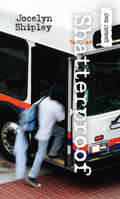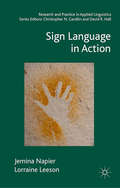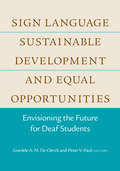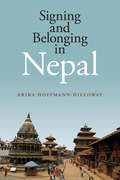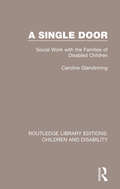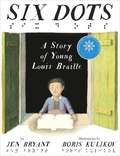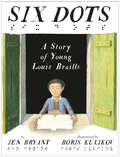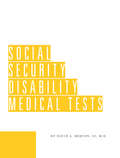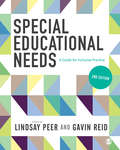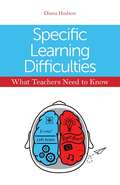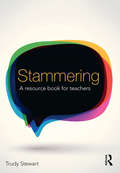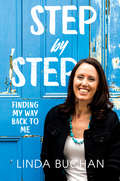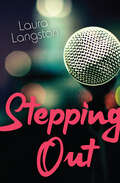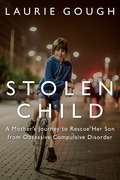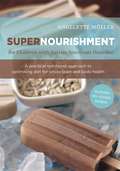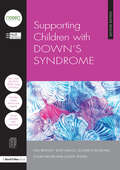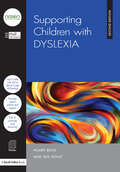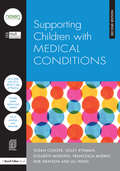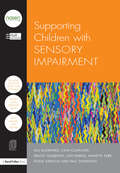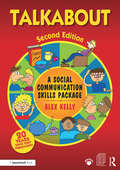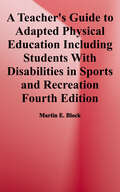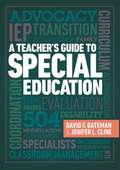- Table View
- List View
Shatterproof (Orca Currents)
by Jocelyn ShipleyThirteen-year-old Nate needs a break from looking after his newly disabled mom. One day when his mom thinks he's at a cross-country meet, he goes to the mall with a friend he's forbidden to have contact with. At the skate shop he sees a new board he can't afford but has to have, and Nate gets talked into running a scam. It turns out Nate looks a lot like a teen TV star filming in the area. So he and his buddy get girls to pay cash to be extras on set. It's all fine until Nate meets a girl he really likes. Nate knows he has to tell her the truth, but he's not sure he has what it takes to come clean.
Sign Language in Action (Research and Practice in Applied Linguistics)
by Jemina Napier Lorraine LeesonThis book defines the notion of applied sign linguistics by drawing on data from projects that have explored sign language in action in various domains. The book gives professionals working with sign languages, signed language teachers and students, research students and their supervisors, authoritative access to current ideas and practice.
Sign Language, Sustainable Development, and Equal Opportunities: Envisioning the Future for Deaf Students
by Goedele A. De Clerck Peter V. PaulIncreased interaction between sign language communities and the mainstream societies in which they function is creating the potential for greater equality of opportunity for people who are deaf and hard of hearing. In this volume, renowned scholars and policy makers from around the world present innovative and groundbreaking perspectives on the relationships among sign language, sustainable development, and equal opportunities. The contributors to this volume offer creative and open-minded explorations of the construct of sustainability that are informed by their work with deaf individuals, deaf communities, families of deaf children, and other stakeholders. Sign Language, Sustainable Development, and Equal Opportunities describes sustainability in relation to: · identity, resilience, and well-being · participatory citizenship · historical perspectives on sign language use in educational contexts · sign language learning and teaching · human rights and inclusive education · literate thought and literacy · the sign language factor and the development of sign language communities in sub-Saharan Africa · sign language legislation These changing communities’ understanding of what is required to become sustainable—in areas such as full participation and citizenship in society, economic well-being, access to quality education, and cultural and linguistic identity—is also taking new forms. This work contributes to the paradigm shifts regarding deaf emancipation and deaf education taking place around the world.
Signing and Belonging in Nepal
by Erika Hoffmann-DillowayWhile many deaf organizations around the world have adopted an ethno-linguistic framing of deafness, the meanings and consequences of this perspective vary across cultural contexts, and relatively little scholarship exists that explores this framework from an anthropological perspective. In this book, Erika Hoffmann-Dilloway presents an accessible examination of deafness in Nepal. As a linguistic anthropologist, she describes the emergence of Nepali Sign Language and deaf sociality in the social and historical context of Nepal during the last decades before the Hindu Kingdom became a secular republic. She then shows how the adoption of an ethno-linguistic model interacted with the ritual pollution model, or the prior notion that deafness results from bad karma. Her focus is on the impact of these competing and co-existing understandings of deafness on three groups: signers who adopted deafness as an ethnic identity, homesigners whose ability to adopt that identity is hindered by their difficulties in acquiring Nepali Sign Language, and hearing Nepalis who interact with Deaf signers. Comparing these contexts demonstrates that both the ethno-linguistic model and the ritual pollution model, its seeming foil, draw on the same basic premise: that both persons and larger social formations are mutually constituted through interaction. Signing and Belonging in Nepal is an ethnography that studies a rich and unique Deaf culture while also contributing to larger discussions about social reproduction and social change.
A Single Door: Social Work with the Families of Disabled Children (Routledge Library Editions: Children and Disability #Vol. 8)
by Caroline GlendinningFirst published in 1986, this study explores the increased public concern with policies of ‘community care’ and their effects on informal carers, at that time. It looks at the widespread evidence that one particular group of informal carers- parents looking after their severely disabled child- lack information, advice and a co-ordinated pattern of supporting services. The author, who carried out research on disabled children and their families for a number of years, describes in detail a low-cost experimental project in which specialist social workers set out to remedy these shortcomings. Drawing on the results of this particular study, the author argues strongly for widespread assignment of ‘key’ social workers to this and other groups of informal carers. Despite being written in the mid-1980s, this book discusses topic that will still be of interest and use today.
Six Dots: A Story of Young Louis Braille
by Jen Bryant Boris KulikovAn inspiring look at a child inventor whose drive and intelligence changed to world-for the blind and sighted alike - The story of young Louis Braille
Six Dots: A Story of Young Louis Braille
by Jen BryantAn inspiring picture-book biography of Louis Braille—a blind boy so determined to read that he invented his own alphabet.**Winner of a Schneider Family Book Award!** Louis Braille was just five years old when he lost his sight. He was a clever boy, determined to live like everyone else, and what he wanted more than anything was to be able to read. Even at the school for the blind in Paris, there were no books for him. And so he invented his own alphabet—a whole new system for writing that could be read by touch. A system so ingenious that it is still used by the blind community today. Award-winning writer Jen Bryant tells Braille&’s inspiring story with a lively and accessible text, filled with the sounds, the smells, and the touch of Louis&’s world. Boris Kulikov&’s inspired paintings help readers to understand what Louis lost, and what he was determined to gain back through books. An author&’s note and additional resources at the end of the book complement the simple story and offer more information for parents and teachers. Praise for Six Dots: "An inspiring look at a child inventor whose drive and intelligence changed to world—for the blind and sighted alike."—Kirkus Reviews"Even in a crowded field, Bryant&’s tightly focused work, cast in the fictionalized voice of Braille himself, is particularly distinguished."—Bulletin, starred review"This picture book biography strikes a perfect balance between the seriousness of Braille&’s life and the exuberance he projected out into the world." — School Library Journal, starred review
Social Security Disability Medical Tests
by David Morton IIIEvaluate Social Security Medical Disability Test Results Effective advocacy requires informed and critical evaluation of your clients' medical tests and their results. Were they properly performed? By the right person? Interpreted correctly? What is the chance of a false negative result? Here you will find normal test ranges, predictive values, relevant listings, proper technique, and more for 470 medical tests. You will be able to critically examine the application of test results to disability claims. Here is the authoritative and detailed guidance from a former SSA Chief Medical Consultant who has personally made more than 50,000 disability determinations. Dr. David Morton's Social Security Disability Medical Tests answers the following questions for nearly every test you will encounter: * When is the test warranted? * Can SSA purchase it? Does it commonly do so? * What are the relevant social security medical listings? * What complications can result? * How should the test be performed? * Is the test objective, providing independently verifiable information based upon observation? Or is it subjective, depending upon the information elicited by the testing physician? * What is the probability that the test will not detect the abnormality? * What is the prevalence of the abnormality in the population? * What is the normal range of test results? The book is written in plain English and details more than 500 medical tests frequently encountered in SSA disability determinations. Real-life examples and explanatory drawings accompany many texts. Medical terms are explained as they occur in the text. Over 700 medical abbreviations are defined. Also provided are more than 80 normal laboratory test values and eight different treadmill stress test protocols.
Special Educational Needs: A Guide for Inclusive Practice
by Gavin Reid Lindsay PeerCovering contemporary policy issues, perspectives from practice and a range of common syndromes and barriers Special Educational Needs presents a wealth of information and guidance for students and professionals on how to achieve effective, inclusive practice. Second edition features include: · fully revised annotated further readings and links to useful websites; · a new chapter on Autism and Applied Behaviour Analysis (ABA) · a new chapter on Down Syndrome · updated reference to legislation, including the SEND Code of Practice (2014) · updated case studies covering 0-18 age range This comprehensive course text is ideal for students, teachers, practitioners and specialists, and provides a solid foundation for understanding and supporting learners with additional needs.
Special Educational Needs: A Guide for Inclusive Practice
by Lindsay Peer Gavin ReidCovering contemporary policy issues, perspectives from practice and a range of common syndromes and barriers Special Educational Needs presents a wealth of information and guidance for students and professionals on how to achieve effective, inclusive practice. Second edition features include: · fully revised annotated further readings and links to useful websites; · a new chapter on Autism and Applied Behaviour Analysis (ABA) · a new chapter on Down Syndrome · updated reference to legislation, including the SEND Code of Practice (2014) · updated case studies covering 0-18 age range This comprehensive course text is ideal for students, teachers, practitioners and specialists, and provides a solid foundation for understanding and supporting learners with additional needs.
Specific Learning Difficulties - What Teachers Need to Know
by Jon English Diana HudsonThis book clearly explains what Specific Learning Difficulties (SpLD) are, and describes the symptoms of conditions most commonly encountered in the mainstream classroom: dyslexia, dyspraxia, dyscalculia, dysgraphia, Autism Spectrum Disorder, ADHD, and OCD. The author provides an overview of the strengths and weaknesses commonly associated with each of these conditions, as well as practical suggestions for modifying teaching materials and methods to make learning enjoyable, effective and accessible for students. There are also dedicated chapters on helping students with SpLDs to develop effective revision skills and exam techniques. This straight-talking and accessible guide is ideal for teachers, teaching assistants, and those in school management who want to know more about supporting students with Specific Learning Difficulties.
Stammering: A resource book for teachers (Overcoming Common Problems Ser.)
by Trudy StewartWhat is stammering? How does it present itself? When does it occur? Why does it happen? What are the most effective strategies you can use to help? Providing background information about stammering as well as a wide range of tools and strategies, this practical book addresses the key challenges faced at nursery and school. There are separate sections on early years, primary and secondary level and include the most common areas that teachers must consider when supporting children who lack speech fluency, including: identifying children at risk of developing a stammer how to manage incidents of stammering how to manage classroom communication and oral participation helping children to make and maintain relationships help children to manage feelings associated with stammering working alongside speech and language therapists. Recent changes to the curriculum means that there is now a greater demand on children’s communication skills than ever. This book will help you provide the necessary support to a child who stammers by offering a clear explanation of the presentation of stammering and the best ways you manage the occurrence of stammering in a range of school contexts. Full of tips and advice this book will enable teachers and other professionals to work effectively with a child who stammers. This accessible book is essential for anyone concerned about a child in their care who presents with a stammer, including teachers, student teachers, SENCOs and parents.
Step By Step: Finding My Way Back to Me
by Linda BuchanMy name is Linda Buchan and when I was 18 years old I died... On a winter's day, Saturday June 27, 1998 my young life ended and my new life began. A life that was to be so completely different to the one that I had envisaged, the one that I had expected... ... In the days, weeks, months and years that followed I was often stricken with pain, sadness, despair, distress and heartbreak but I never for one moment thought about giving up. I didn't know where it came from but I always had hope, I always knew that I would not only survive but that my life would get better. In Linda Buchan's raw and powerful memoir she shares her journey from the terrible night when the life and future she thought lay ahead of her was shattered. From that moment she began a new life, firstly fighting just to survive, then forging her way with incredible courage and determination to live a fulfilling and purposeful life on her own terms. She is living proof of her own mantra It's not what happens to you. It is how you deal with it. Linda's way of dealing with what happened to her has been to combine acceptance and contentment, finely mixed with determination and an undeniable drive and passion for life. Her athletic background underpinned her physical determination and mental willpower, which helped her recovery immensely. To this day she draws on all of these attributes. Linda is the embodiment of her mantra "it's not what happens to you. It's how you deal with it." She is an inspiration to us all. - Janine Shepherd AM
Stepping Out (Orca Limelights)
by Laura LangstonLaughter is fifteen-year-old Paige Larsson's currency in life. It takes the sting out of life's tough stuff. It eases the pain of nasty comments, agonizing moments in gym class and awkward pauses at parties. She likes it even more when others laugh with her, so she's become a YouTube comedy vlogger. Now Paige is about to step out of her comfort zone and compete--live and onstage--in the prestigious International Teens in Comedy festival. Winning will give her the opportunity to work with some of the biggest names in comedy. It'll also mean $10,000 for her school's performing-arts department. But Paige has always used her humor to mask the pain of a disability, and in the world of stand-up comedy, that won't cut it anymore.
Stolen Child: A Mother's Journey to Rescue Her Son From Obsessive Compulsive Disorder
by Laurie GoughA year in the desperate life of a boy transformed by OCD from a bright ten-year-old into a stranger in his own skin. Although Laurie Gough was an intrepid traveller who had explored wild, far-off reaches of the globe, the journey she and her family took in their own home in their small Quebec village proved to be far more frightening, strange, and foreign than any land she had ever visited. It began when Gough's son, shattered by his grandfather's death, transformed from a bright, soccer-ball kicking ten-year-old into a near-stranger, falling into trances where his parents couldn't reach him and performing ever-changing rituals of magical thinking designed to bring his grandpa back to life. Stolen Child examines a horrifying year in one family's life, the lengths the parents went to to help their son, and how they won the battle against his all-consuming disorder.
Successful Social Stories™ for Young Children: Growing Up with Social Stories™
by Siobhan Timmins Carol GraySocial StoriesTM are acknowledged as a very successful way of teaching concepts and social understanding to children with autism spectrum disorders, but considerable skill is needed to write the most effective story. This clear and engaging book introduces ways of thinking about the issues your child finds difficult, and includes 32 stories created by Dr Siobhan Timmins for her son during his early years, with helpful explanations of how she did it, and what the underlying thinking was behind each set of stories. She explains how the stories build upon each other to help the child to understand further, more complex topics, and how to see the connections so that you can best help your child. From basic skills such as learning to listen, wait and share, to common fears, this book takes the mystery out of creating effective Social StoriesTM and amply demonstrates how to put together a cohesive set of stories which your child can understand and relate to.
Supernourishment for Children with Autism Spectrum Disorder: A Practical Nutritional Approach to Optimizing Diet for Whole Brain and Body Health
by Angelette MullerThis comprehensive guide provides everything you need to transition your child with autism to a nutrient-packed diet. It will increase your understanding of nutrition and autism by · explaining how diet supports the function of brain and body (including learning and attention, energy production, sensory processing and gut-brain communication) · describing how a highly processed diet can lead to nutritional deficiencies and how to choose more nutritionally dense options · looking at the science behind the challenges that children with autism face, such as problems with processing carbohydrates or ingredients such as phenols and oxalates. It then guides you through making dietary changes, offering · a range of breakfast, lunch, dinner, snacks and drinks recipes that are easy to follow and prepare. · coding to indicate which recipes can be used in conjunction with specialist diets including GF, CF, SCD, FODMAP and GAPS (so if your child is on a specific diet, this book is still for you) · practical tips on how to build a meal and plan a weekly menu · advice on overcoming common feeding challenges and poor eating habits. This book will be an invaluable addition to the shelves of parents of children with ASD as well as health practitioners such as nutritionists and dieticians who want to know more about autism.
Supporting Children with Down's Syndrome (nasen spotlight)
by Hull City CouncilThis practical resource contains a wealth of valuable advice and tried-and-tested strategies for supporting children and young people with Down’s Syndrome. Fully updated with the 2014 SEND Code of Practice, this text describes the different types of difficulties experienced by pupils with Down’s Syndrome and helps practitioners to understand their diverse needs. The wide-ranging chapters explore a variety of topics, including: Defining the profile of a pupil with Down’s Syndrome Guidelines for working with pupils Addressing behaviour issues The use of ICT Home/school liason Assessment It provides guidance and practical strategies for SENCOs, teachers and other professionals and parents, helping them to feel more confident, and be more effective in supporting learners in a variety of settings. It also provides materials for in-house training sessions, and features useful checklists, templates and photocopiable resources.
Supporting Children with Dyslexia (nasen spotlight)
by Hull City CouncilCompletely revised and updated in light of the new 2014 SEND Code of Practice, this second edition of Supporting Children with Dyslexia provides valuable advice and resources for teachers, TAs and SENCOs supporting pupils on the dyslexic spectrum. This practical resource will help those who are looking for expert guidance and strategies, as well as providing a professional development tool which will encourage outstanding practice at all levels. Spanning pre-school, primary and secondary teaching, this book covers the key areas to be considered when supporting pupils with dyslexia, including: how to identify a young person with dyslexia practical strategies for pre-school, primary and secondary settings useful advice to give to parents and carers of children and young people with dyslexia useful materials for continual professional development. Featuring helpful checklists, templates and photocopiable resources, this book provides guidance and practical strategies for identifying and supporting young people with dyslexia that will be of use to teachers, TAs, SENCOs and other educational professionals.
Supporting Children with Medical Conditions (nasen spotlight)
by Hull City CouncilThe fully revised new edition of Supporting Children with Medical Conditions provides teachers and practitioners with a reference to medical conditions most commonly found amongst school-aged children, including asthma, cerebral palsy, cystic fibrosis, eczema, epilepsy, head injuries, heart conditions, hydrocephalus and spina bifida. With up to date advice for practitioners, each condition is clearly described in terms of causes, symptoms and treatment, and the authors accessibly explain the educational implications – what teachers and support staff should be aware of, how they can minimise pupils’ difficulties in school and maximise access to the curriculum. With all the vital information practitioners will need to know about Medical Conditions, this book includes: Definitions of different Medical Conditions and their educational implications Guidelines for staff providing intimate personal care for pupils Suggestions to allow pupils to have full access to the curriculum Fully updated with the 2014 SEND Code of Practice and the guidance published in 2014 on ‘Supporting pupils at school with medical conditions’, this text will help professionals be more effective in supporting learners in a variety of settings. It also features useful checklists, templates and photocopiable resources.
Supporting Children with Sensory Impairment (nasen spotlight)
by Hull City CouncilThis book provides a quick and easy reference guide to different types of sensory impairment, including causes, symptoms and the implications on teaching and learning. With most children and young people with hearing or visual impairments attending mainstream schools, this book explains the most effective and practical strategies for use in mainstream classrooms. Fully up to date with the 2014 SEND Code of Practice, this accessible resource is split into two sections: Supporting Children with a Hearing Impairment and Supporting Children with a Visual Impairment. The wide-ranging chapters include: Educational access for pupils with hearing loss Teaching phonics Teaching deaf pupils with English as a second language Identifying children with visual impairment Classroom management Adapting resources This practical text provides strategies to use in schools to ensure that children with sensory impairments are fully supported. Featuring useful checklist and photocopiable resouces, it contains a wealth of valuable advice and tried-and-tested strategies for teachers and support staff working in early years settings, schools, academies and colleges.
Take Charge of Treatment for Your Child with Asperger's (ASD): Create a Personalized Guide to Success for Home, School, and the Community
by Shonda Schilling D. Scott Mcleod Cornelia Pelzer ElwoodEquipping you with the knowledge and tools to become an effective case manager for your child, this book provides straightforward, practical instructions to create a comprehensive guide to your child's unique ASD profile. The individualized guide will: - Provide information about your child's unique profile for anyone who needs it - Serve as a toolbox and teaching template for your child's teachers and support team, with effective strategies to use with him or her - Be an instruction booklet for your child, helping him or her to thrive at home, school and in the community - Act as a case management road map to help you support your child and collaborate with teachers and service providers. The book includes checklists and worksheets, which can also be accessed online, so that you can easily create a personalized guide for your child with autism aged 5-14.
Talkabout: A Social Communication Skills Package (Talkabout)
by Alex KellyThis core Talkabout manual is a practical resource essential for Speech and Language Therapists and other professionals who need to help people with special needs develop social skills. Over 60 activities form an extensive, structured social skills programme that can easily be adapted for use with children, adolescents and adults. Written by bestselling author and practising Speech and Language Therapist, Alex Kelly, this book sits at the centre of an internationally renowned series of resources supporting social skills. Contents include: a social skills assessment and intervention planning tool to help you identify the best way forward for each client or group over 60 activities focussing on body language, conversation and assertiveness 25 group cohesion activities to help you facilitate well-run, productive group sessions a wealth of handouts supporting the activities that can be freely downloaded and printed. This updated second edition of Talkabout sits alongside Talkabout for Teenagers and Talkabout for Adults, as well as three titles published for children (Developing Self Awareness and Self Esteem, Developing Social Skills and, Developing Friendship and Skills).
Teacher's Guide to Adapted Physical Education: Including Students with Disabilities in Sports and Recreation
by Martin E. BlockA healthy and active lifestyle for all students: That's the promise of physical education, and the goal of this comprehensive textbook. Now in a thoroughly updated fourth edition, this text prepares current and future PE teachers to lead welcoming, inclusive classes where every student participates, makes friends, and learns new skills and values. K - 12 physical educators will get cutting-edge research and guidance on inclusive education, concrete strategies for planning and implementing an adapted PE program, and valuable disability-specific information. An essential resource for preparing both general PE teachers and adapted PE teachers, this text will provide a solid foundation for gym classes that meet every student's needs. This new edition has: 9 chapters on teaching students with specific disabilities, making it an ideal text for APE courses; more student-friendly features including updated tips and reproducible forms for planning and teaching, chapter objectives, additional resources, and more case studies; and more photos and illustrations throughout the book to emphasize key points.
A Teacher's Guide to Special Education
by David Bateman Jenifer ClineDespite the prevalence of students with disabilities in the general education classroom, few teachers receive training on how to meet these students' needs or how to navigate Despite the prevalence of students with disabilities in the general education classroom, few teachers receive training on how to meet these students' needs or how to navigate the legally mandated processes enumerated in the Individuals with Disabilities Education Act (IDEA). What is their role? What are their responsibilities? What are the roles and rights of parents? And what must all teachers do to ensure that students with disabilities and other special needs receive the quality education they're entitled to? In this practical reference, David F. Bateman--bestselling author of A Principal's Guide to Special Education --and special education administrator Jenifer L. Cline clarify what general education teachers need to know about special education law and processes and provide a guide to instructional best practices for the inclusive classroom. Topics covered include The pre-referral, referral, and evaluation processes Individualized education programs (IEPs) and the parties involved Accommodations for students who do not quality for special education, including those covered by Section 504 Transition from preK to K-12 and from high school to postschool life Classroom management and student behavior Educational frameworks, instructional strategies, and service delivery options Assessment, grades, graduation, and diplomas The breadth of coverage in this book, along with its practical examples, action steps, and appendixes covering key terms and definitions will provide the foundation all K-12 teachers need to successfully instruct and support students receiving special education services. It's an indispensable resource for every general education classroom. the legally mandated processes enumerated in the Individuals with Disabilities Education Act (IDEA). What is their role? What are their responsibilities? What are the roles and rights of parents? And what must all teachers do to ensure that students with disabilities and other special needs receive the quality education they're entitled to? In this practical reference, David F. Bateman--bestselling author of A Principal's Guide to Special Education --and special education administrator Jenifer L. Cline clarify what general education teachers need to know about special education law and processes and provide a guide to instructional best practices for the inclusive classroom. Topics covered include The pre-referral, referral, and evaluation processes Individualized education programs (IEPs) and the parties involved Accommodations for students who do not quality for special education, including those covered by Section 504 Transition from preK to K-12 and from high school to postschool life Classroom management and student behavior Educational frameworks, instructional strategies, and service delivery options Assessment, grades, graduation, and diplomas The breadth of coverage in this book, along with its practical examples, action steps, and appendixes covering key terms and definitions will provide the foundation all K-12 teachers need to successfully instruct and support students receiving special education services. It's an indispensable resource for every general education classroom.
